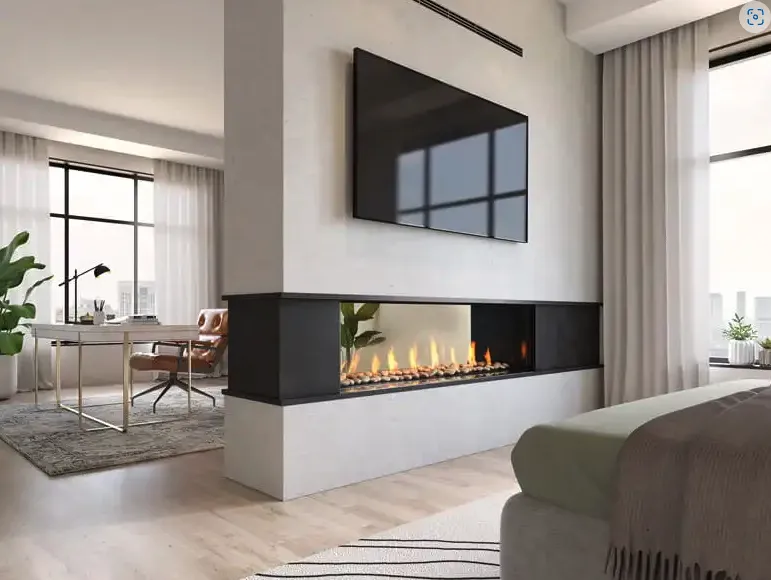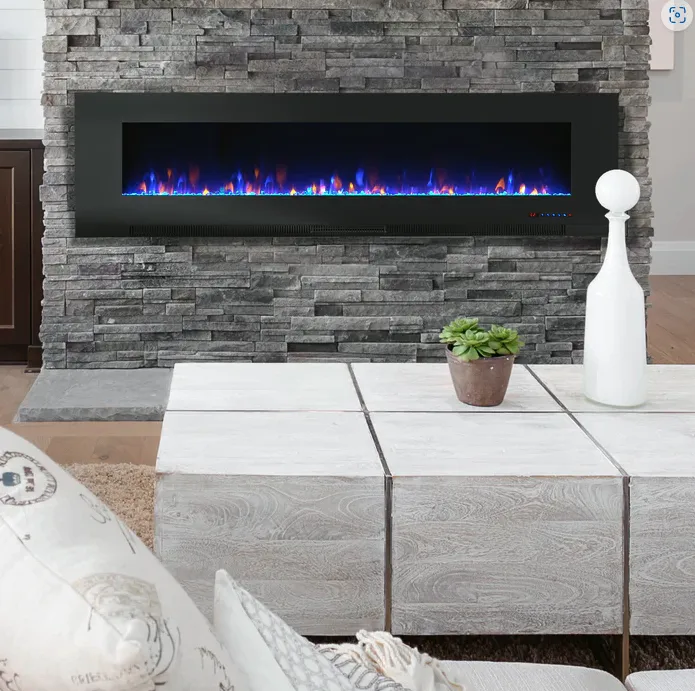

You have the perfect spot for a hearth. But the big question is: should you choose a gas or electric fireplace?
Gas fireplaces offer powerful, consistent heat, but need a gas installation service for setup and venting. Electric fireplaces are easier and cheaper to install, but need backup power during outages. So, which one?
This guide will help you choose the perfect fireplace for your home. You’ll learn the differences between types and the important factors to consider. Let’s get started.

A gas fireplace is a modern heating device that uses natural gas or propane, offering quick, hassle-free warmth. Unlike wood fireplaces, there’s no need to chop wood or clean ash.
Its main component is the burner with adjustable jets that produce yellow flames over decorative ceramic logs, pebbles, or coals, all protected behind tempered glass.
Typically, gas fireplaces burn 10 to 35 megajoules of gas per hour. They provide about 2.8 to 9.7 kilowatts of heat.

An electric fireplace is a self-contained heater that plugs into a standard outlet, requiring no vents or chimneys. It heats via electrical resistance using ceramic panels or metal coils, producing 1.5 to 5 kilowatts of heat.
The firebox, made of stainless steel or aluminium with a tempered glass front, is designed for even heat distribution, often with built-in fans.
Most models feature remote controls or control panels for adjusting flame brightness, temperature, and timers.

Here’s how gas and electric fireplaces are different:
Deciding between an electric or gas fireplace comes down to your fuel choice.
Gas fireplaces run on natural gas or propane, delivered through a gas line. If you already have a gas line, installation is simple.
Electric fireplaces, on the other hand, run on electricity and only need a standard outlet. This is perfect if you don’t have a gas line.
The type of fuel shapes how you install a fireplace. Gas fireplaces need a licensed professional like a gas fitter or plumber to meet Australian safety standards such as AS/NZS 5601.
They need a dedicated gas line and a vent or flue to safely remove combustion gases outside. This must follow rules on height, clearance, and materials to prevent smoke buildup and carbon monoxide hazards.
Electric fireplaces are simpler, requiring only a standard outlet. No gas lines or vents. Wall-mounted models are easy to hang, while built-in ones may need framing, making installation less complicated.
This is the most visible distinction when we are talking about gas vs electric fireplaces. Gas fireplaces produce realistic yellow and orange flames through incomplete combustion, reaching 400°C–600°C.
Electric fireplaces use LED lights and mirrors to simulate flickering flames, which don’t produce heat. Instead, a separate heater provides warmth, and a remote allows you to change flame color, brightness, and flicker speed.
The gas vs. electric fireplace debate mainly hinges on heat output in BTUs.
Gas fireplaces are powerful, ranging from 20,000 to over 60,000 BTUs, suitable for large spaces, but are only 70-90% efficient due to vent heat loss.
On the other hand, electric fireplaces produce about 4,000 to 5,000 BTUs, ideal for smaller rooms like bedrooms, and are 100% efficient, converting all electricity into heat.
A gas fireplace uses non-flammable materials such as steel or refractory bricks for the firebox. Its ceramic fibre or cement “logs” mimic real wood and withstand over 1,000°C, with a ceramic glass front.
An electric fireplace, made from lighter materials such as MDF, plastic, and thin metal, creates a flame effect with LEDs and a mirrored roller. Its front panel is typically glass or acrylic, which stays cool to the touch.
Gas fireplaces often keep working during power outages because they don’t rely solely on electricity. Many have a pilot light or millivolt system, and some newer models include batteries for ignition.
These are the things that you need to discuss with your professional plumbers during the gas line installation process
Electric fireplaces, on the other hand, require power to operate and turn off completely during outages.
Cost is key when choosing between gas and electric fireplaces. Gas units in Australia range from 2,000 to over 15,000, covering the unit, installation, gas lines, venting, and safety checks, with more complex setups costing more.
Electric fireplaces are cheaper to install, often just requiring a plug and framing, with running costs around 0.30 to 0.60 per hour. Overall, electric fireplaces have lower installation costs, while gas options are more expensive upfront.
The safety of gas or electric fireplaces depends on their material and fuel source, a key consideration for homeowners.
Gas models burn fuel and produce flames, posing risks such as burns, leaks, or carbon monoxide, but modern units have safety features such as shut-off valves and protective screens.
Electric fireplaces are safer, as they lack flames and combustion, keeping surfaces cool and reducing hazards around children and pets, with automatic shut-off for added safety.
Gas fireplaces require regular cleaning of the burner, pilot light, leaking gas meter, and venting to prevent issues. A licensed technician should inspect them every one or two years for wear, leaks, and proper ventilation.
Electric fireplaces are easier. Simply dust, wipe the screen, and keep vents clear. Without burners or vents, they require little maintenance, making them a convenient choice for those who prefer non-gas fireplaces.
Also Read: Gas Fireplace Pilot Won’t Light? Do These Steps!
Here are some important things to consider before choosing a fireplace:
Installing a new fireplace is exciting, but running out of fuel can quickly spoil the experience. Many homeowners overlook this until it’s too late.
If your home has a natural gas line, gas fireplaces are dependable. In rural areas without natural gas, you can use LPG tanks, but they require regular checks and scheduled deliveries.
Electric fireplaces are easy to install with a standard outlet but can leave you without heat during power outages, which are common in rural areas.
When deciding between a gas or electric fireplace, consider your home’s layout and space.
Gas fireplaces require a chimney and gas line. If you do not have these, a professional must install vents, which can be challenging in apartments or rooms without outside walls.
Electric fireplaces are easier. They only need to be plugged in and can be hung on the wall or placed on a shelf, making them suitable for small spaces.
If you just want to warm a small room now and then, an electric fireplace works well. It provides quick, targeted heat to make a bedroom cosy without getting too hot.
However, if you need a dependable heat source to keep your home warm all winter, a gas fireplace is a good choice. Designed to work hard, it provides steady, strong heat that can warm large, open spaces for hours.
So, think about your daily routine. If staying warm during a blackout matters most, a gas fireplace with a pilot light is the only option that can run completely off-grid.
Your budget often guides your fireplace choice. However, focusing only on installation costs can be misleading. You also need to consider your monthly electricity or gas bill for fireplace usage.
Don’t just consider the installation cost. Remember, your monthly electricity or gas bill will also add up over time. The real expenses can include maintenance and potential repairs, too.
A gas fireplace has higher installation costs but lower fuel expenses if used frequently. An electric fireplace is cheaper to buy and install, with no maintenance such as gas meter adjustment. However, electricity costs can be higher.
When choosing between a gas or electric fireplace, consider the air quality, especially if you have children or older family members.
A gas fireplace creates a real fire by burning fuel. While modern gas fireplaces are safe and vent fumes outside, they still burn fuel indoors. This can release tiny amounts of harmful gases that may cause breathing problems.
An electric fireplace doesn’t produce any fumes or pollution. It’s a safer choice if you want clean air inside your home.
Choosing a fireplace isn’t just about warmth or cost. It’s about the mood you want to create at home.
A gas fireplace provides authentic charm with flickering flames and glowing embers, creating a cosy centrepiece.
An electric fireplace offers a modern, versatile alternative with customised light displays, colour options, and adjustable flames. This adds style and warmth in a sleek way.
When you add a fireplace to your home, safety comes first, especially if you have family members who need extra protection. Both gas and electric fireplaces are safe but require precautions.
Gas fireplaces have real flames and hot glass, so a safety screen and professional installation are vital to prevent burns and leaks.
Electric fireplaces are safer since they lack real flames. Just use the correct circuit and keep vents clear of obstructions for safe operation.
Choose a gas fireplace if:
Choose an electric fireplace if:
Here are some questions to help you decide whether to choose a gas or electric fireplace:
Gas fireplaces cost less to run, usually about 20 to 30 cents an hour. They use natural gas, which costs about 2 to 4 cents per unit, and a typical fireplace uses 10 to 15 units each hour.
Electric fireplaces cost more, around 30 to 50 cents an hour, because electricity is more expensive. If you use your fireplace often, gas is the cheaper option.
For a gas fireplace, you face higher installation costs, up to $2,500, including venting. It also carries safety risks, such as carbon monoxide leaks, so it requires proper maintenance.
On the other hand, electric fireplaces don’t have real flames and don’t produce as much heat. So they’re not ideal for large rooms. Plus, they run on electricity, so a power outage means no heat at all.
Not all homes have the same setup. Some use direct-vent fireplaces that vent through pipes. These models need a chimney or vent to carry gases outside.
Others are vent-free, but they’re best suited for small rooms that meet certain ventilation standards.
A gas fireplace burns natural gas or propane to produce a real, flickering flame. In contrast, an electric fireplace uses electricity to heat a room with coils and creates a fake flame.
Understanding how these two systems work explains why they differ in installation, running costs, and heat output. With this knowledge, you can choose the system that best suits your home: gas or electric fireplace.
If you opt for a gas model, have it installed by a professional for safety. Still have a doubt? Call us at Melbourne Gas Plumbing for advice and to make your choice with confidence.


Fill the form below and we’ll get back ASAP!

MGP! Thank you for help, honest pricing and high quality work. Thank you to Joe for pricing and the boys involved for replacing my hot water tank and fixing my gas leak for a reasonable price. 5 star response, 5 star service and 5 star price.
Joe was great. Very professional and quick. Gas hot water heater needed replacing, he was honest and upfront about what our options were. System was sourced and replaced within a couple of hours.
Fantastic service very responsive Joe is highly recommended and works very clean and neat..... good job well done....very happy... will use again and again

At Melbourne Gas Plumber, we're here to handle all your gas plumbing needs throughout Melbourne. With over 40 years of experience, we bring extensive local knowledge and expertise to every job.
QUICK LINKS
OPENING HOURS
Open 24/7
